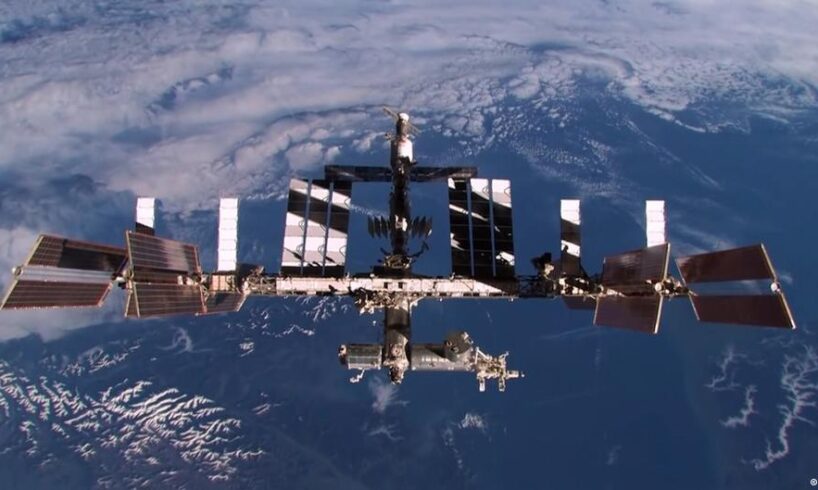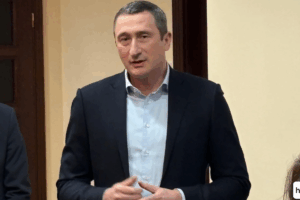
Securing a conversation with Leonidas Askianakis requires foresight. His schedule is carved into 30-minute slots from 5 a.m. until 11 p.m. Meetings are online only, and every one of them revolves around space.
Despite the long hours, his calendar is booked weeks ahead. When does he sleep?
The 22-year-old student from the Technical University of Munich in Germany shrugs when confronted with the question during a recent interview with DW, saying that he’s “on the home stretch” and just can’t “set the project aside.”
Even at night, the mission weighs on him, he said, and he often lies awake scrolling through recent reports from a Chinese space mission which has identified more debris and increasing risk.
Leonidas Askianakis has secured both generous public funding and venture capital for his Project-S startupImage: Sandeep Barstools
In early November, a Chinese crew had to extend its stay in orbit because their return capsule might have collided with fragments. Space junk, Askianakis says, has become something like his calling.
A growing hazard overhead
Thousands of tons of debris now circle Earth — retired satellites, spent rocket stages, and countless shards. The European Space Agency (ESA) estimates more than 1.2 million objects larger than one centimeter (0.39 inches) in orbit, including over 50,000 bigger than 10 centimeters.
“Between 700 and 800 kilometers [434 miles to 497 miles] in altitude we’re seeing massive debris clouds that will remain for centuries and can multiply through collisions,” Jan Siminski of ESA’s Space Debris team in Darmstadt, Germany, told DW.
A one-centimeter fragment is enough to destroy a satellite, he added, because “a collision releases the energy of a hand grenade.”
Earth’s orbit is full of lingering space junk Image: ESA
Global monitoring systems track the largest pieces around the clock, but most debris remains invisible. “With our ground-based radar, we can typically detect objects about the size of a tennis ball,” Siminski said. “Anything smaller we can’t detect, which means there’s always residual risk.”
The need for a ‘commercial cleanup plan’
That risk has preoccupied Askianakis since his first semester in aerospace engineering. “How can debris stay in orbit for 200 years and no one does anything?” he wondered after a lecture.
He searched for allies on campus and at workshops, usually without success. “In 2021, hardly anyone connected waste with space,” he recalled. It wasn’t until a semester break on Crete that the idea of removing space debris on a commercial basis crystallized.
An encouraging conversation with Airbus officials at the IAA mobility trade fair in Munich accelerated the decision to launch a startup company. “They understood the problem and were glad someone was tackling it,” he said.
Soon after the Project-S startup was founded, a new EU space law came into force, requiring satellite operators to dispose of their debris, giving Askianakis’ project a timely boost.
Space debris is threatening satellites
To view this video please enable JavaScript, and consider upgrading to a web browser that supports HTML5 video
Project-S plans to deploy satellites equipped with high-sensitivity radar and proprietary algorithms designed to detect fragments between one and 10 centimeters. They would enable continuous, comprehensive orbit surveillance for the first time. Later, robotic cleanup probes are to remove larger pieces.
Bavaria’s state-backed ambitions
Space startups, however, require far more than personal passion. Who would invest in a debris-removal venture run by someone still in his early twenties?
“We would,” says the economics minister of the German federal state of Bavaria, Hubert Aiwanger.
Bavaria has invested more than €245 million ($284 million) in various space projects, including a planned lunar operations center and several high-innovation startups.
“Companies and research institutions can pursue projects here that might never materialize elsewhere,” Aiwanger told DW, adding that the regional state wants to remain the “backbone of European spaceflight.”
Bavaria’s political leaders such as state premier Markus Söder (left) and Hubert Aiwanger show great enthusiasm for space projectsImage: Peter Kneffel/dpa/picture alliance
Receiving co-funding from the state to the tune of €1 million, Askianakis says his Californian investors were shocked to hear that Bavaria gave the funding without taking equity. “They asked: ‘You just get funding like that?'”
Project-S is now scheduled to launch its first space mission in 2026. The state grant gives the project independence, says Askianakis, because many US investors might require founders to relocate. “Why would I do that when I have ideal conditions in Bavaria?” he noted.
From punchline to space power
Bavaria’s space sector is also looking to Berlin, where the federal government has announced €35 billion in upcoming space and defense investments.
Aiwanger calls it a good start, but not enough. The state will continue to push forward on its own, he said, “because we understand both the potential and the responsibility.”
The German Space Operations Center near Munich already controls the European module on the ISS and coordinates with NASA in human spaceflightImage: Sachelle Babbar/IMAGO
A few years ago, the idea of Bavaria becoming a space hub, including the construction of satellites, training astronauts, or even launching a lunar mission, might have drawn laughs.
But today, Bavaria’s space boom is no longer science fiction but economic strategy.
The region now accounts for more than 10,000 high-skilled jobs and has secured €2.9 billion in ESA contracts — nearly 40% of Germany’s total ESA funding since 2015.
As Bavaria reaches for the stars, Askianakis wants to ensure the route upward stays clear. After all, someone has to create room when Earth’s orbit gets crowded.
This article was originally written in German.





